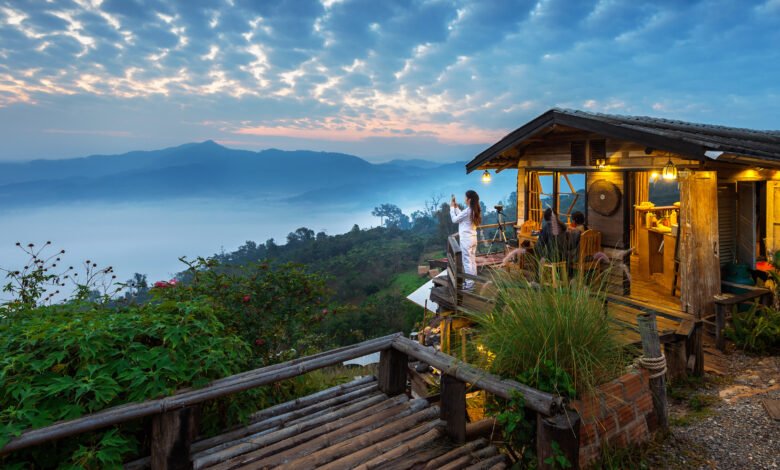Chiang Mai Pictures: Capturing the Soul of Northern Thailand

Chiang Mai, the “Rose of the North,” is a visual feast where ancient temples pierce misty mountains, vibrant markets pulse with life, and golden light bathes emerald rice fields. More than just a destination, it’s a photographer’s dreamscape—a place where every alleyway, hilltop, and festival tells a story. Whether you’re an amateur with a smartphone or a seasoned pro, Chiang Mai’s blend of spiritual serenity, cultural richness, and natural grandeur offers endless frames waiting to be captured. This article explores the iconic scenes and hidden gems that define Chiang Mai’s visual poetry.
1. The Sacred Silhouettes: Temples at Dawn
Chiang Mai’s skyline is dominated by wats (temples), where centuries-old chedis and intricate naga serpent statues stand guard. At sunrise, Wat Doi Suthep emerges from the clouds atop its mountain throne, offering panoramic views of the city below. Within the Old City walls, Wat Chedi Luang’s ruined pagoda, partially reclaimed by banyan roots, whispers of Lanna Kingdom history. Capture monks in saffron robes circling the cloisters at Wat Phra Singh, where the interplay of shadow and gold leaf creates ethereal compositions. These sacred spaces demand reverence—shoot quietly, avoid flash near murals, and embrace the soft morning light filtering through ancient teak.
2. Nature’s Embrace: Mountains, Waterfalls & Highland Tribes
Beyond the city, Chiang Mai’s wild heart unfolds. Drive the serpentine roads to Doi Inthanon National Park—Thailand’s highest peak—where moss-draped forests, tiered waterfalls like Wachirathan, and terraced rice paddies paint a lush tapestry. Near Mae Kampong village, long-exposure shots of cascading waters framed by jungle ferns reveal nature’s raw power. In hill tribe villages like Doi Pui (Hmong) or Mae Chaem (Karen), document daily life: elders weaving textiles, children tending water buffalo, or the vivid indigo fabrics drying under mountain sun. Ethical photography is key: always ask permission, support local crafts, and avoid intrusive lenses during private moments.
3. Bustling Narratives: Night Bazaars & Street Scenes
As dusk falls, Chiang Mai transforms. The Night Bazaar along Chang Klan Road erupts in a kaleidoscope of lantern glow, sizzling street food smoke, and mounds of hill-tribe embroidery. Use a wide aperture to isolate details: a vendor’s wrinkled hands arranging mangoes, or monks accepting alms at Tha Phae Gate at dawn. Sunday Walking Street on Ratchadamnoen Road offers candid moments—artists sketching portraits, dancers in traditional fingernail costumes, or the steam rising from a bowl of khao soi. For dynamic shots, embrace high ISO settings and capture motion blur in the swirling crowds, symbolizing the city’s vibrant pulse.
4. Festivals of Light & Color: Yi Peng and Songkran
Timed with lunar cycles, Chiang Mai’s festivals are visual spectacles. During Yi Peng (November), thousands of khom loi (sky lanterns) float into the night like constellations, while temples glow with candlelit krathong floats on rivers. Use tripods for long exposures to trace lantern paths against starry skies. At Songkran (April), the world’s biggest water fight becomes a joyful chaos of drenched revelers, powder-smeared faces, and pickup trucks transformed into mobile pools. Freeze water-splashes with fast shutter speeds, or slow motion to capture the laughter in droplets—a testament to Thai resilience and joy.
5. Hidden Frames: Alleys, Cafés & Artistic Enclaves
Wander beyond tourist hubs to find Chiang Mai’s quieter narratives. Nimmanhaemin’s artsy lanes hide murals of mythical thep angels and minimalist coffee shops where light streams through bamboo lattices. In the Old City’s soi, document weathered wooden shophouses draped in bougainvillea, or cats napping beside spirit houses. Visit Baan Kang Wat artist village, where potters, weavers, and painters work in open studios—ideal for intimate environmental portraits. These scenes thrive in the “blue hour” when fading twilight softens contrasts, revealing the city’s contemplative soul.
Conclusion: More Than a Snapshot
Chiang Mai’s beauty isn’t just in its postcard-perfect temples or misty peaks; it’s in the harmony of ancient and modern, sacred and playful, wild and woven. Great Chiang Mai pictures tell stories of resilience—monks scrolling smartphones beside 14th-century stupas, farmers harvesting rice under drone-filled skies. They invite viewers not just to see, but to feel: the cool temple marble, the market’s chili-scented air, the monks’ chants carried on mountain winds. As you frame this Northern Thai jewel, remember that respect shapes the truest images—pause, connect, and let the moment guide your lens.
FAQ: Chiang Mai Photography Essentials
Q: When is the best time for photography in Chiang Mai?
A: Cool season (November–February) offers clear skies, misty mornings, and festivals like Yi Peng. Green season (June–October) brings dramatic clouds and lush landscapes—perfect for waterfall shots. Avoid March–April’s smoky “burning season” due to agricultural fires.
Q: Are drones allowed at temples or festivals?
A: Most temples prohibit drones without permission. Festivals like Yi Peng ban them entirely for safety. Fly legally: register with Thailand’s NBTC, avoid crowds, and respect no-fly zones near airports or palaces.
Q: How can I photograph monks respectfully?
A: Always ask permission before taking close portraits. Avoid shooting during private prayers. Wider shots of temple life (e.g., monks walking or studying) are less intrusive. Never touch a monk if you’re female.
Q: Where can I learn traditional photography techniques in Chiang Mai?
A: Workshops at Chiang Mai Photo House (film development) or Master John’s Darkroom (alternative processes) offer hands-on learning. Many guesthouses also host photowalks.
Q: What gear should I prioritize?
A: A versatile zoom lens (e.g., 24-70mm) handles temples and markets. Pack a tripod for lantern festivals and waterfalls. A prime lens (35mm/50mm) excels in low-light street scenes. Rain covers are essential in monsoon season!
Q: Any etiquette tips for hill tribe photography?
A: Never pay for photos—it encourages exploitation. Support communities by buying crafts instead. Ask village leaders for consent, avoid photographing children without parents, and dress modestly.



